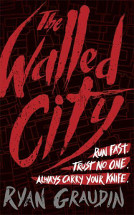The Walled City by Ryan Graudin

Indigo, 2014. ISBN 9781780621999
Not suitable for younger readers. In the brutal, lawless Walled
City, violent criminals are in control whilst broken, lost souls
such as street children try to survive anyway they can, living in
filthy squalor and being wary of everyone.
Most of the story centres upon a brothel owned by a vicious gang who
press young girls into sexual slavery. Accordingly, the subject is
grim with women being forcibly detained, savagely beaten, sexually
assaulted and prostituted for the profit of the gang's leader.
The violence and competition for survival on the streets is such
that to stay alive, children must run from ever present threats and
be handy with a knife to defend themselves. Two characters have
reason to gain entry to the brothel, Jin Ling seeks to rescue an
enslaved sister, whilst Dai is under immense pressure to accomplish
a task before a given date. Cooperating requires that the pair break
the primary rule of survival, being 'Trust nobody'. This is no small
matter given the hair raising exploits the pair become involved in,
with each having the other's life in their hands on occasion. The
mystery of Dai's race against time and his reason for being in the
city took too long to reveal and became annoying and boring rather
than captivating.
One of the many confronting aspects of this story is that it is
based on the Kowloon Walled City, however it is set in contemporary
time. A story such as this set in a futuristic, dystopian society or
even a Medieval fantasy world enables escapism, however the setting
of this tale firmly emphasises that many women do experience this
barbarous mistreatment in our modern world. Given that lives of
violence and sexual exploitation are a reality for too many women
and children, it is valid for adults to be prompted to feel deeply
about the misery and degradation experienced by the less fortunate.
Whether this is fit and appropriate for adolescent readers is a
complex question which many will have diverse, strong opinions
about.
My own feeling is that the evil practices portrayed in this novel
are not depicted gratuitously yet readers will be disturbed.
Further, it would be concerning if readers were not disturbed by
this issue but I don't consider that the novel has enough depth to
make it compelling literature. For this reason I urge parents to
read it carefully before giving it to their children and suggest
that librarians and teachers exercise caution in regard to whether
this is appropriate for their collection and if so, which age levels
may borrow it.
Rob Welsh